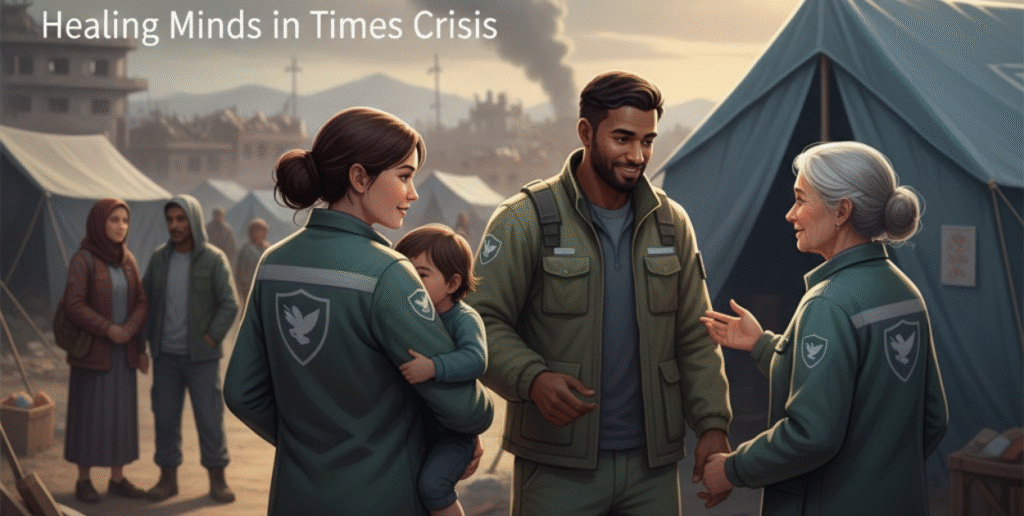
There’s a hidden cost to heroism. Disaster response teams experience tragedy, fear, and destruction as normal, ongoing parts of their daily responsibilities.
Not only are they physically at risk every time they show up to work, but they’re consistently paying an emotional toll for every disaster they come across.
Studies have shown that PTSD and other mental health struggles are very common in first responders. They experience regularly a level of anxiety that most people will never know in their entire life.
Not only is this corrosive to the individual, but it can influence their decision-making ability and consequently their job performance.
In this article, we take a look at why and how disaster response teams can prioritize mental health.
Mental Health is Important for all
Before we get too far into the article, let’s state our position clearly: mental health is important individually for all of us.
In the context of first responders, there’s a wider cultural and societal connotation. We all depend on disaster relief professionals and are therefore incentivized to ensure they have everything they need in order to thrive.
Physically, most people already understand this. No one would wonder, for example, why a firefighter needs an oxygen tank before they go into a burning building. It should be equally self-evident why these same first responders need and deserve help dealing with the emotional burden of their work.
No one would say to that firefighter with the tank that they should be responsible for procuring their own oxygen on the job. After all, didn’t they know the building would be hot and suffocating before they showed up to work?
Absurd though that position so clearly is, there’s a widely accepted equivalent when it comes to mental health considerations.
Interior well-being is not something that should be taken up only in one’s spare time. It should be baked into the job description of people who regularly experience trauma, fear, and physical risk.
Understanding the Unique Mental Health Challenges First Responders Experience
There is a compounding effect that comes from regularly experiencing trauma. The interior result is essentially the same as the PTSD experienced by veterans—when your brain is constantly activating a fight-or-flight response, the impact can eventually become lingering.
Post-Traumatic Stress Disorder is a disruption of our brain’s stress response. Hormonally speaking, someone suffering from PTSD is experiencing frequent and often unpredictable misfires of their amygdala, or the brain’s fear center.
It’s not only when a person witnesses a war that this can take place. The only real requirement is constant exposure to true conditions that activate the adrenaline response in your body.
Building Mental Health Support from the Ground Up
Our modern understanding of how stress impacts the brain is relatively recent, and consequently, evidence-based resilience-building techniques are equally new.
To ensure a mentally and physically healthy first responder workforce, it’s important to prioritize mental health literacy from the very earliest moments of training.
Much of this is simply about ensuring that first responders understand and have the tools to respond to typical psychological reactions to trauma.
Often, there is a mythology behind emergency response services that celebrates toughness in a way that can, if left unchecked, create unrealistic expectations.
Of course, first responders are tough. But having a stress or anxiety response to difficult situations is a natural reaction.
That isn’t indicative of a person’s strength. First responders should be taught this from the ground up in a way that de-stigmatizes stress and anxiety and, consequently, improves their ability to perform at the highest level when lives are at stake.
Practical Steps
Here are a few practical and effective techniques for building mental health awareness and literacy into disaster response:
- General education: First responders should know going in what types of adverse reactions are common to their profession. This will help them recognize stress signs early and take actionable steps to address them before they spiral out of control.
- Realistic preparation: Disaster response teams already use realistic simulations to train first responders. It can be helpful to integrate mental health awareness into these processes as a way of both emphasizing their importance and actively practicing skills—skills that first responders can use on the job.
- Emphasizing the importance of support systems: It’s also important to communicate expectations to first responders about maintaining healthy support networks.
- Personal support systems: Partners, friends, and family members should have information on what to expect and how they can serve as a resource to the people in their lives.
These steps are ultimately relatively small, but when taken seriously and emphasized consistently, they can have a big impact on how first responders experience their jobs.
A Holistic Response
How do natural disasters impact human life? Often, the focus is so heavily oriented around physical or financial consequences of a natural disaster.
These are, of course, impactful and worthy of consideration, but they can’t be the beginning and end of the response.
There is a lingering emotional risk that will often have the longest-lasting impact on individuals who experience natural disasters, regardless of the context.
What does it look like in practice? The steps we described above are a great first start. The rest should be tailored to the specific circumstances of the unit experiencing the risk.
That’s the thing about trauma. It’s very individualized, and there’s no singular response for managing stress, anxiety, and all of the consequences that stem from these conditions.
There are many mental health professionals who can collaborate with first responders to reduce the risk of lingering consequences. The more mental health is prioritized, the better first responders and the people that they save will be able to recover from disasters.
Mariam holds an MS in Sociology with a specialization in Medical Sociology and Social Psychology. With a strong academic background and extensive research work in both fields, she brings depth and clarity to complex topics. Her writing explores the intersection of society, health, and the human mind, making academic ideas easy to grasp and relevant to everyday life.


